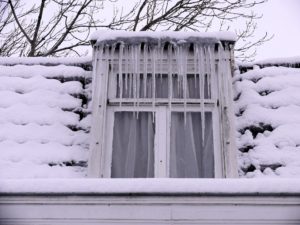
What are they?
Ice dams, you want to know how to avoid them but let’s first look at what they are! Ice dams are typically built-up areas of ice at your home’s roof edge which prevents the melting snow from draining off your roof, just like a beaver’s dam but on your roof. This dam causes havoc in your home by allowing the water to infiltrate into the interior and cause damage to your walls, ceilings and insulation which can lead to mold and other headaches. If there are no beavers on your roof how are these dams being created? Weather! Yes, actually it is related to the exterior temperature and the differences in temperature between the edge of your roof and the roof’s upper portion.
A temperature difference can make quite an impact. If the temperature outside is 32 degrees or below and you have snow on your roof watch out. If warm interior air leaks to the upper portion of your roof to start to melt the snow and the lower portion down by your eave is 32 degrees or lower that melted snow ends up becoming ice at the edge causing the start of an ice dam and eventually builds up enough to give you problems. The area above the ice stays in the state of melted snow (water) and will find ways to sneak into your home.
Where are they?
In an existing home, you can identify areas of potential trouble by looking at your roof after a snowstorm. Identify areas that are melting faster than the eave. This is most likely an area where heat is escaping into the attic causing a more rapid melt than at the eave. The goal is to create a uniform temperature throughout your attic.
The 7 techniques…
- Provide a properly vented attic. This is enforced in New Jersey by the International Residential Code 2015 and you should make sure your general contractor pays close attention to it. In addition make sure your architect notes them on his/her drawings.
- Make sure you have enough insulation in your attic! If you have room to exceed the minimum do so. The prescriptive package in accordance with the International Energy Conservation Code requires R-49 in attics for homes in North Jersey. However using a software called ResCheck can cut this number down by adding insulation elsewhere to help you save money but may end up costing you more down the road in repairs.
- Exhausts from all appliances, such as dryers, hoods and bathrooms should all vent through a side wall or roof never though a soffit.
- All recessed lights that are penetrating into attic space shall be IC (insulation contact) fixtures which can have insulation placed right over them.
- All attic ductwork shall be sealed and insulated with a minimum value of R-8.
- Caulk and seal all penetrations such as wiring, vent pipes et al.
- Have an ice and water shield installed under your roof shingles in accordance with manufacturer’s instructions. Locations to be addressed are roof edges and valleys. A quality job will include all the penetrations as well! This shield does not prevent ice dams but it can help protect your home if it should occur.
If you see on your existing home that ice dams are forming the best thing to do is broom off the snow at the roof edge and try and melt the ice to allow the water to flow down and off the roof. Travelers, insurance company, recommend putting sodium chloride ice melt product in a stocking and laying it over the source of build up. I’m not 100% sold on this method but it looks like it could be a short-term remedy in a pinch.
Enjoy the winter and be careful!


